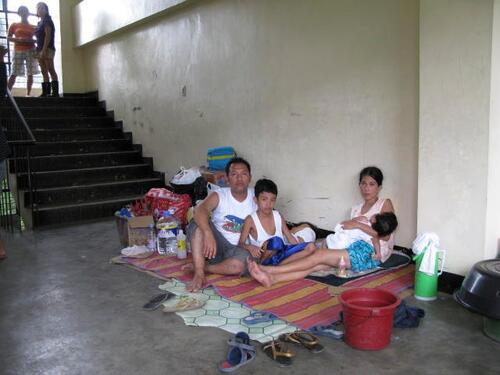Eyewitnesses to the devastation At the Pasig’s evacuation center, Manila Metro area, Sunday, October 4
Marco works in a supermarket in downtown Manila. He used to live in Pasig city, near the river. Marco is married and has three children. For a week now he has been living with his family of five in Pasig’s evacuation centre - a local school. Like hundreds of thousands of others from Manila and surrounding areas, he has been displaced by the floods. The whole family looks tired and anxious. They sit on pieces of cardboard. Marco speaks quietly, his eyes red from lack of sleep.
“Saturday, when the water started to rise, I was in the supermarket where I work, as usual.
I received an SMS from my wife: ‘Quick. Come home. The water is rising!’ I asked my supervisor if I could go and started to run to catch a train. Unfortunately, the trains were already blocked because of the flooding. In the city, there was water everywhere. I couldn’t get home. I was terrified. After a few hours, my wife called me, to say ‘I am on the second floor and I have water up to my hips! Please come!’ But there was nothing I could do.
“I stayed outside the whole night and on Sunday morning I managed to come here to Pasig where I found two of my children. My wife and my four month old baby were still in the house, with such a small child she couldn’t get out. I went to rescue her. The water level was already starting to go down.
“We have received food, clothes and the hygiene kit MSF brought us today but we are still living in this corridor. It’s noisy, windy...it is not a place for a family.
“We have been here now for a week and we plan to go back to our house on Monday even if it’s still covered with mud and rubbish. We are lucky we still have our house. Our neighbour has lost everything.”
Marco and his neighbour Amy, sits next to them. She seems tired and nervous and as she talks, tears fill her eyes.
“When the water was coming up, it was horrible,” she said. “It came so fast that some people were trapped in their house. You could hear them shouting for help. Some had to break the roof of their house to escape....It was horrible.
“I have lost everything. My house was washed away by the floods. I wasn’t able to take anything when I left but the clothes I was wearing. I have nothing left and no money. I used to work as a waitress earning US$2 a day. I might go back to my village which I left two years ago. I might try and walk there...I don’t know what to do....I have lost everything.”

Today an MSF team is going to Tuguegarao, a city in the north of the country, to carry out an evaluation of the needs of the people living there.
The rains accompanying Parma were less than expected, much to the relief of the inhabitants of Manila, many of whom saw their homes go under water following flooding caused by typhoon Kestsana, that hit the Philippines a week ago on Saturday.
Ketsana, according to official figures, killed 300 people and displaced 320,000 in Manila and surrounding areas. In total, a population of 3.9 million has been affected.
"Heavy rains would have exacerbated an already very difficult situation,” said Oifa Bouriachi, MSF Emergency Coordinator. “Manila and regions close by were devastated by last week’s tropical storm. Tens of thousands of families are still living in evacuation centres and our teams are continuing to assess the needs and provide help where necessary.”
MSF has sent an emergency team of 20 to provide assistance. Two mobile clinics are providing medical consultations in some of the 505 evacuation centres in Manila and surrounding areas. Seventy consultations are being offered per day, by each mobile clinic and support includes a mental health component for people experiencing post traumatic stress conditions.
MSF is also distributing non-food items to people staying in the evacuation centres, including hygiene kits for 6,500 people. A mobile clinic and non-food item distribution (soap, bowls, and plastic sheeting) will begin in Laguna Bay, south-east of Manila tomorrow. It is an area that is still totally under water and around 100,000 people are living in evacuation centres.
Continual assessments of the situation are being carried out by MSF teams in and around Manila, including by helicopter. The response by Philippine authorities has been prompt and effective, but despite this, some areas have still not received any assistance. The vastness and topography of the region makes it difficult to access populations that may be in urgent need of assistance. Meanwhile, the population remains anxious.
“It is the monsoon time in the Philippines and it is feared that more heavy rain may fall in the coming days,” explained Bouriachi. “The weather forecasts are not looking good. More flooding would be catastrophic for a population that is already in a very vulnerable situation, with large areas still under water. Everyone remains vigilant.”


